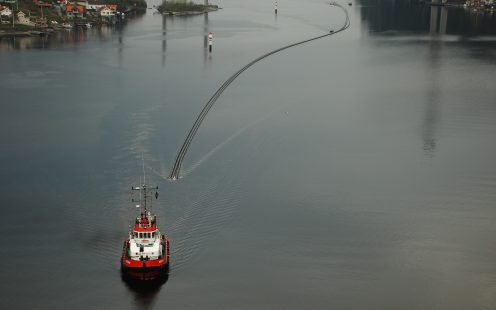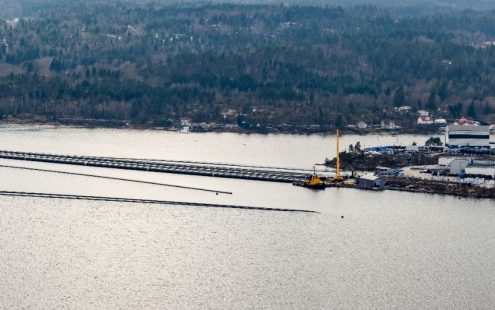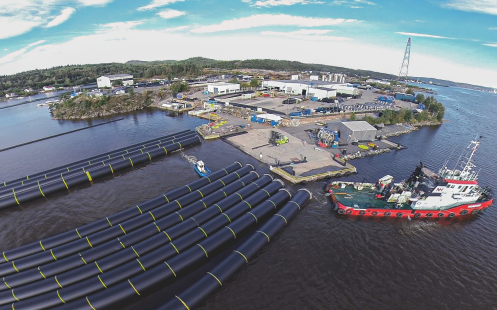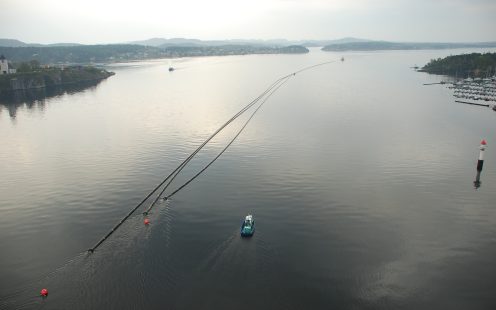No Welding and More Safety: Kilometer-Long PE Cable Ducts for Offshore Wind Farms
Renewable energy projects often require innovative technical solutions. With the offshore wind farm industry growing, one of the essential considerations is the safe and effective installation of protective ducts for the export cables as they come on shore. In recent years, continuously extruded long-length PE pipes have been increasingly deployed to achieve this. The Moray East project in Scotland is among the several wind farms that have opted for the benefits of non-welded PE ducts produced by Pipelife Norway.
.jpg)
Limitations of Welded PE Pipes for Offshore Applications
PE pipes have been used as ducts to protect electrical cables for decades. However, the standard short lengths, measuring 6 or 12 meters, require storage on land and have to be welded together to form the ducts for longer cables.
Whilst properly welded PE pipes can be used for offshore purposes, a slight angular deflection of the pipe can occur. Particularly in longer lengths, this angular deflection can become significant and create challenges for the installation.
In addition, an inner and outer bead is formed as part of the welding process. Removing these beads, especially on the inside of the ducts, can be problematic and expensive. The removal can also require verification that no part of the inner bead remains creating an obstruction when the cable is installed.
Outer beads or remains of such can increase friction when pulling a duct into the drill bore. If the bore is long, the friction can be substantial and may only be overcome by increasing the pulling forces, which raises damage risks when installing the duct.
Furthermore, constructing the ducts on land requires a long pipe spread with adequate space to store, weld and test the pipes. Then, typically, they must be towed over land prior to entering the water for installation. Onshore and offshore marine licenses are generally required, alongside compliance with stringent environmental conditions.
Long-Length PE Pipes as a Next Generation Solution
Pipelife’s factory in Stathelle, Norway, is a specialist facility, purpose-built to produce HDPE pipes in large diameters and extremely long lengths. The maximum pipe length produced is 1400 meters long. Dimensions range from 20 mm OD to 2500 mm OD, with a wall thickness of up to 120 mm.
The pipes are extruded into a fjord and towed from Stathelle directly to the installation site. Several pipes can be towed at once, offering an environmentally friendly and cost-efficient alternative to transportation and storage onshore.
The long lengths of Pipelife’s PE pipes reduce handling and welding needs on the site. Once arrived, the pipes can be ballasted, submerged and installed efficiently. Transportation and storage by sea also prevent deformations that can occur if pipes are stored on land for prolonged periods.
Hundreds of major international and domestic tows have been already completed attesting to Pipelife Norway’s logistics expertise. The long-length HDPE pipes have been delivered to clients’ marine construction sites in Europe, Africa, North and South America, and Asia.
.jpg)
.jpg)
Reliable Ducts for Offshore Wind Farms
Pipelife Norway has also delivered pipes for several wind farm projects, with pipe lengths often exceeding 1 kilometer. One such project was the Moray East, located on the East coast of Scotland. The recently completed wind farm comprises 100 wind turbines and has a generating capacity of 950 MW.
The Principal Contractor (Offshore), NKT, awarded the landfall HDD subcontract to LMR Drilling UK. Three boreholes were drilled and lined with PE pipes to form the landfall cable ducts. The seamless extruded, no-weld pipes were 600 mm OD with a wall thickness of 35.6 mm in lengths of 995, 1010 and 1032 meters.
Managing Director of LMR Drilling UK Ltd, Jez Seamans explains the use of the long-length PE pipes as ducts in boreholes: “The professional approach demonstrated by Pipelife throughout the procurement process ensured that the pipe was completely fit for the purpose. The quality was excellent, with no welds to cause any interference in the installation of the cables into the ducts. Pipelife worked closely with our client and us, meaning risks associated with the delivery and installation were identified and mitigated at all stages of the process.”
The contractor NKT supplied and installed electrical cables for the ambitious project. Experienced in cable solutions for offshore wind farms, the company appreciated the non-welded ducts used.
“Safe and durable cable protection systems are crucial in the rough environment of offshore power plants. Avoiding welding reduces installation risks and reliability issues later on. We are very happy with the quality of Pipelife’s long-length pipes. The close collaboration with Pipelife and the timely delivery of the ducts were other important criteria ensuring the project was completed smoothly and without delays,” comments Jacob Zeemann, Senior Site Manager of NKT.
.jpg)
the Energy Sector
Offshore wind farm development is on the rise throughout Europe, and the UK is no exception. Due to higher and steadier wind speeds over the sea, offshore turbines typically yield higher and more reliable energy production than onshore units.
The Moray East Project is estimated to supply up to 950,000 homes in Scotland with renewable energy, saving up to 1.7 million tons of CO2 emissions every year. The offshore wind farm is already fully operational and has a crucial role in the country’s transition towards a carbon-neutral economy.
Discover our power supply solutions
Get in Touch
Please choose your preferred way to get in contact with us. We will get back to you as soon as possible.
Fill our form